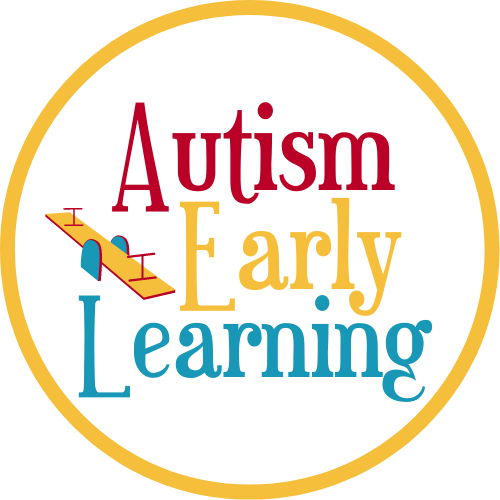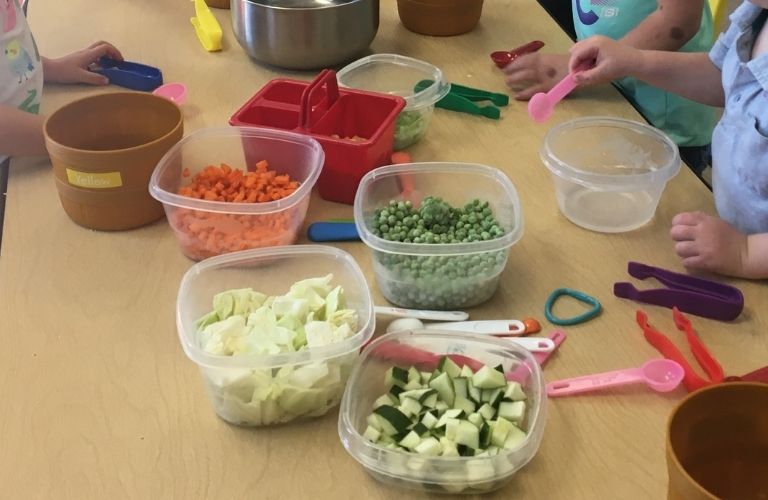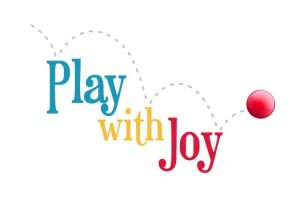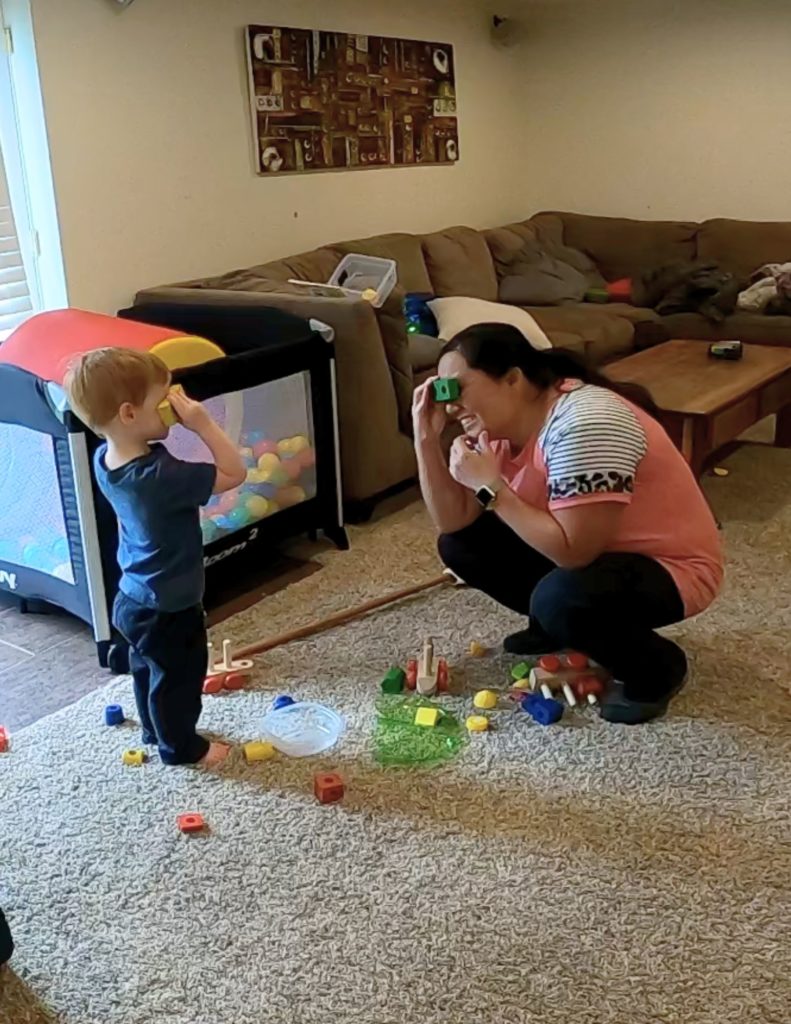Here’s another fun activity for kids that I’m going to be adding to the Early Intervention Activity Library.
This activity is good for young kids, but I bet older kids would enjoy it too. Just remember that small kids can choke on small pieces easily, so adult supervision is highly suggested. Also, cut the food into appropriate sized pieces. I know this is obvious, but I thought I better state it anyways 🙂
Here are the things I like about this activity
- You can make the book come alive (pre-literacy)
- It’s a way to expose kids to different kinds of foods without putting pressure on them to eat it (especially for kids who have food aversions)
- Kids can explore and create however they want to
- You can work on communication skills during this activity
- You can do this as a group incorporating social skills
- Fine motor is embedded
- You can also target executive functioning skills, cognitive skills, and adaptive skills
The book I like to use with this activity is Rainbow Stew by Cathryn Falwell. It’s about some kids that get to spend the day with their grandfather. They go explore outside and pick foods from the garden. Then they get to make stew with all the colorful vegetables they picked.
The book can be a bit wordy, so when I’m working with younger kids or kids that have a difficult time attending for long periods of time, I just make up my own words. You can just label pictures, or say things like “I see something green. It’s a green zucchini. Let’s pick the zucchini for our stew.”
After reading the book you can either have the food ready for your child to create a stew, or you can go search for the food together. You can hide the food around and do it like an egg hunt, or you can just search in the fridge. If you have a garden, even better!
Scooping is fun (and great for fine motor), so put out a big bowl of water and some measuring cups for your child to do his own scooping.
You can add some more fine motor by adding different types of utensils to use. You can get some kid tweezers (I’ll post a picture at the bottom so you know what I”m talking about), you can have different sized spoons, add some spices and measuring spoons. Get creative and allow your child to get creative too! That’s what’s so fun.
If you’re able to do this as a group activity, it’s really great for working on social skills. Here are a few skills you can work on.
- Sharing (only have one container per food item for the kids to share)
- Waiting for a turn
- Offering a turn
- Making a comment to a peer
- Parallel play
- Cooperative play
- Act out the story, everyone takes a specific role
- Play restaurant
- Play house
- Play school lunch
- Play gardeners
When I do this with my preschool classes, they love it! It’s fun to see how proud they are when they create their very own stew.
If you’d like to more info on how to adapt this activity and target specific developmental skills, you can purchase the complete activity below or in the store.
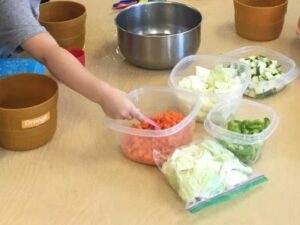
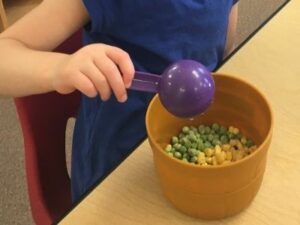
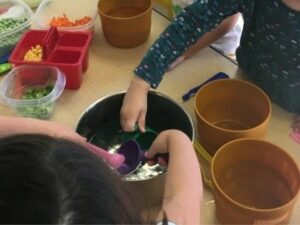
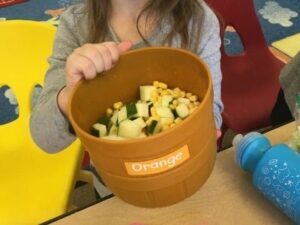

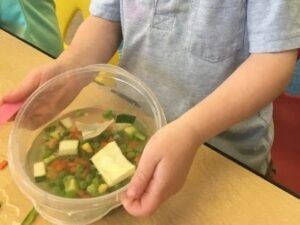
Ingredient Ideas
- Chopped Carrots
- Chopped Peppers
- Chopped Celery
- Frozen Peas
- Frozen Corn
- Seasonings
- Bowls
- Spoons
- Water
Instructions
- Chop a variety of veggies and put them in individual containers
- Set out a bowl of water with a ladle or large spoon
- Set out seasonings
- Give your child a small mixing bowl or a small pot to make their stew
- Allow your child to explore and create his own rainbow stew
Extra Tips & Ideas
- A good book to go along with this activity is Rainbow Stew by Cathryn Falwell.
- If your child is a picky eater, this is a good way to give her exposure to new foods. Don't force her to eat it, but let her explore the food with her hands.
- Disclaimer: Young children may choke on small pieces, make sure food is cut small. Adult supervision recommended.
Access The Full Tutorial
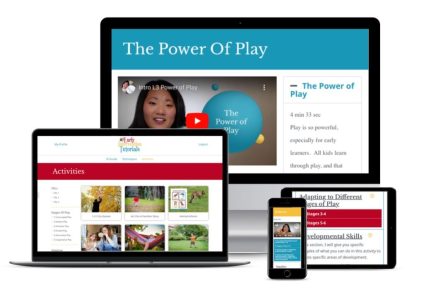
To gain full access to this tutorial and 70+ other activity and technique tutorials, become a member of The Early Intervention Tutorials
As a member of the EI Tutorials, you will learn how to:
- Identify a child’s developmental level
- Understand the stages of play
- Learn how to help a child with limited play skills
- Implement specific techniques to increase communication and engagement
- Adapt activities to different stages of development
- Target specific developmental skills, including: communication skills, cognitive skills, executive functioning, motor skills, social skills, and adaptive skills
Adapting to Different Stages of Play
Depending on a child’s stage of development, you’ll want to adapt this activity based on goals that would be appropriate for the child’s growth.
The stages of play are:
- Stage 1: Unoccupied Play
- Stage 2: Solitary Play
- Stage 3: Onlooker Play
- Stage 4: Parallel Play
- Stage 5: Associative Play
- Stage 6: Cooperative Play
I’ll share ideas on how to do this in the Early Intervention Tutorials. You can become a member and gain access to this tutorial by going to: https://autismearlylearning.com/ei-tutorials-info/
Developmental Skills
In this section, I’ll identify which areas of development this activity targets. I’ll also give some pointers on how to specifically target each area. You can become a member of the Early Intervention Tutorials by going to: https://autismearlylearning.com/ei-tutorials-info/
Download
- Printable Lesson Plan (only available in the Early Intervention Tutorials)
Links
As a Walmart Affiliate, I earn from qualifying purchases at no cost to you.
Here are just a few ideas of what you could use for this activity. Most things like bowls, measuring cups, spoons, and spices you’ll likely have around the house.
